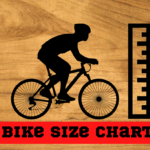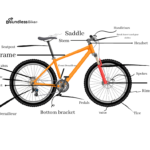Are you new to mountain biking and wondering how high your seat should be? Or maybe you’ve been riding for a while but aren’t sure if your current seat height is optimal for your riding style. Look no further, because, in this blog post, we’ll be diving into the ins and outs of finding the perfect seat height for your mountain bike. Say goodbye to discomfort and hello to a smoother ride!
Mountain Bike height Chart
| Rider Height | Inseam | Saddle Height |
|---|---|---|
| 4’10” – 5’1″ | 23″ – 27″ | 14″ – 15″ |
| 5’2″ – 5’5″ | 27″ – 29″ | 15″ – 16″ |
| 5’6″ – 5’9″ | 29″ – 31″ | 16″ – 17″ |
| 5’10” – 6’1″ | 31″ – 33″ | 17″ – 19″ |
| 6’2″ – 6’4″ | 33″ – 35″ | 19″ – 21″ |
| 6’4″ + | 35″ + | 21″ + |
To determine your saddle height, measure your inseam length (the distance from your crotch to the ground while standing with your feet shoulder-width apart), and use the chart above to find the appropriate saddle height for your height and inseam. Keep in mind that these measurements are approximate, and your ideal saddle height may vary based on your riding style and personal preferences. It’s always a good idea to consult with a professional bike fitter for more personalized recommendations.
Mountain Bike Seat Height Recommendations

When it comes to mountain bike seat height, there is no “one size fits all” answer. The ideal seat height for you will depend on your specific body proportions and riding style. However, there are some general guidelines that can help you get in the ballpark of the right seat height for you.
First, start by sitting on your bike with your feet flat on the ground. You should be able to rest your hands lightly on the handlebars and reach the pedals with ease. If you can’t reach the pedals or if you have to stretch to reach the handlebars, your seat is likely too low. On the other hand, if your legs are fully extended and you feel like you’re perched on top of the bike, your seat is probably too high.
Another way to find a good starting point for Seat height is by taking your inseam measurement (the distance from your crotch to the ground). Most mountain bikes have a range of seat heights that will accommodate riders with different inseams. For example, a bike with a 17-inch frame might have a seat height range of 27.5 to 32 inches. This means that someone with a 30-inch inseam would likely be comfortable on this bike at either end of the seat height range.
Of course, these are just general guidelines. The best way to find your perfect mountain bike seat height is to experiment until you find a position that feels comfortable and efficient – just like riding a bike should!
How High Should My Mountain Bike Seat Be?
The height of your mountain bike seat should be adjusted to ensure maximum comfort and efficiency while riding.
A good starting point is to adjust the seat height so that your leg is fully extended at the bottom of the pedal stroke. You should be able to touch the ground with your toes while sitting on the saddle.
To find the proper seat height, sit on the saddle with one pedal at the bottom of its stroke, and place your heel on the pedal. Your leg should be fully extended, but your hips should not rock side-to-side.
Once you have set the seat height, take a test ride and adjust as necessary. If your knees are bent too much at the bottom of the pedal stroke, raise the seat. If your hips rock side-to-side or your knees lock out at the bottom of the stroke, lower the seat.
Remember that the correct seat height may vary depending on your riding style, terrain, and personal preference, so it’s always a good idea to experiment with small adjustments until you find the perfect fit.
Importance of proper seat height in mountain biking

Proper seat height is essential in mountain biking for several reasons:
- Comfort: A properly adjusted saddle height helps to distribute your weight evenly over the bike, reducing pressure on your hands, arms, and back, and allowing you to ride more comfortably for longer periods.
- Power and Efficiency: The correct seat height allows you to pedal efficiently and transfer maximum power to the pedals. When the saddle is too low, you can’t generate enough power and you may tire quickly, while when it’s too high, you can’t apply enough pressure to the pedals and you may experience knee pain or other injuries.
- Safety: A saddle that is too high or too low can cause you to lose control of your bike, especially when navigating rough terrain or technical sections. A proper saddle height allows you to maintain stability and control while riding.
- Performance: A properly adjusted saddle height can improve your performance and help you ride faster, climb hills more easily, and maneuver through technical sections more effectively.
- Injury Prevention: Incorrect saddle height can lead to various injuries, including knee pain, hip pain, lower back pain, and even nerve damage. A properly adjusted saddle height can help to prevent these injuries and keep you riding pain-free.
In summary, proper saddle height is crucial for comfort, efficiency, safety, performance, and injury prevention in mountain biking. It’s essential to take the time to adjust your saddle height and ensure that it’s suitable for your riding style, terrain, and body size.
How to Adjust Your Mountain Bike Seat Height?
If your seat is too low, you’ll rock back and forth and put unnecessary strain on your knees. If your seat is too high, you’ll put extra strain on your hamstrings and lower back. The ideal mountain bike seat height puts your pedals at a 3 o’clock position when you’re standing next to the bike. To adjust your seat height, first loosened the bolt at the top of the seat post. Next, raise or lower the seat to your desired position before retightening the bolt.
Troubleshooting Mountain Bike Seat Height Issues
If you’re having trouble with your mountain bike seat height, there are a few things you can do to troubleshoot the issue. First, check to make sure that your seat is at the correct height. If it’s too low, you’ll have a difficult time pedaling; if it’s too high, you won’t be able to reach the ground when you stop.
Next, check your saddle position. If it’s too far forward or back, it can throw off your balance and make it hard to pedal. Finally, make sure that your handlebars are at the correct height; if they’re too low, you’ll have to lean forward uncomfortably to reach them.
If you’re still having trouble after checking all of these things, talk to a professional mountain bike mechanic or take your bike to a local shop for help.
Faq
If your seat is too high, you may experience knee pain or other injuries, and you won’t be able to apply enough pressure to the pedals, which can decrease your power and efficiency. You may also lose control of your bike, especially in technical sections or when navigating downhill.
If your seat is too low, you may not generate enough power, and you may tire quickly. You may also experience lower back pain or hand and wrist discomfort, and you won’t be able to control your bike properly, especially when riding uphill.
No, there is no standard seat height for mountain biking, as it varies depending on your riding style, body size, and terrain. You should adjust your seat height to suit your individual needs and preferences.
Conclusion
With the right mountain bike seat height, you can ensure maximum power, comfort, and safety when out on the trails. Make sure to take your time in adjusting your seat height to ensure it’s as close as possible for optimum performance. Remember that everyone has different body shapes so be sure to practice trial and error until you find what works best for you!






